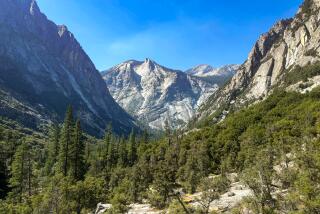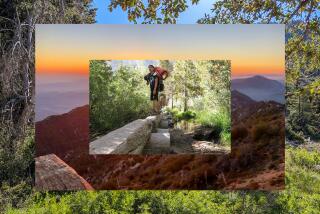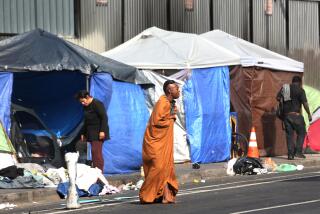Wilderness connection
- Share via
Ah, wilderness: clean air, mountain vistas, star-filled sky and broadband Internet access with e-mail, music downloads, news feeds, stock tickers, sports updates, streaming radio, movie trailers, poker sites, celebrity gossip and information on just about everything. You can even read all about the nature around you in lieu of experiencing it.
Yes, all the wonders of the Internet are now -- or will soon be -- available at a state campground near you. Last winter, the California Department of Parks and Recreation partnered with San Antonio-based communications giant SBC to offer wireless Internet access at 59 state-owned campgrounds. SBC has already made similar connections at state parks in Michigan.
Because it is such a novel concept -- and one so seemingly at odds with the camping experience -- I had to see for myself how it works. The concession agreement between the parks department and SBC was widely touted with initial reports saying that the entire installation would be complete by the end of this month. So far, the service, formally called SBC FreedomLink Service, has been installed in 11 camps, and state officials say it will be the end of the summer by the time they’re completed.
The system has been designed to work like the wireless (WiFi) hotspots in coffee shops, hotel lobbies and airports, ensuring that laptop-toting Internet fiends never need go long without an online fix.
The first state campground to go digital was the hugely popular, vast site at San Elijo State Beach that got the service Jan. 19. The park, located off S. Coast Highway 101 near Cardiff-by-the-Sea, sits on bluffs above a narrow stretch of beach. For purists who hate the idea of the digital world encroaching on this sliver of surf and sand, fear not: The SBC FreedomLink Service here is hardly enticing because of its severe technology limitations.
“We’ve had lots of people asking about it,” said Dave Riley, 21, who works at the park. But Riley, a student majoring in recreation administration at San Diego State University, said the WiFi service was elusive at best. “I’m not sure anybody has actually been able to hook up to it,” he said.
A ranger at San Elijo said she’d also gotten a lot of inquiries since the system was installed, but she had not heard of anyone successfully getting online in the park, leading her to speculate that the system might already be broken.
Shirley Claire is one of the few camp dwellers who has actually used the system, and she has some advice: “Get as close to the camp store as you can.” Claire, 52, has been living at San Elijo in her RV for several weeks and is a park host.
Her determination to go online led her to briefly park in one of the 20-minute spaces in front of the camp store, near the small antenna that transmits the WiFi.
“I got a signal!” she said triumphantly.
I found that the best reception seemed to be in the coin-operated laundry room next to the store. Indeed, with my laptop perched on a folding table, I could Web surf while watching actual surfers through the windows.
The system allows free access to several state-sponsored Web pages that have information about the campground system. You can even make a reservation for a future visit. But if you want to wander on the Web, you will be charged a minimum of $7.95 for a day’s access (payable online by credit card), or a monthly subscription for $19.95 that allows full use of any of the 6,000 SBC hot spots nationwide, including those found in McDonald’s and Barnes & Noble. Customers who subscribe to SBC broadband service at home get a price break -- $1.99 a month -- but only if they sign up for one year.
SBC is paying to install the system in state campgrounds, and the parks department gets 10% of the revenue from customers who sign up for the service in a park.
But the range of the WiFi signal hardly lives up to the SBC announcements that claimed the service would be available at “picnic tables, tents, RV spaces and cabins of more than 70 million visitors who enjoy the state park system every year.”
Wandering around San Elijo with a laptop, I found that a broadband signal reached only about 10 campsites, out of the 171 in the park.
A ranger at San Clemente State Beach, the second park to receive the service, said the signal there was also limited, generating complaints from campers.
SBC spokesman Steven Smith said the system was designed to work at a maximum of 200 feet from the transmission equipment and is doing just that. He said that although upgrades are not planned, the company will continually evaluate the service.
If RV-style camping is the look of the future -- with all its convenience and annoyances (several San Elijo campers seemed to believe that a loud stereo system enhanced the experience for everyone around them) -- then WiFi has a good chance of catching on in these settings. Certainly there’s an appetite for it.
Tom Twitchell, 50, was parked at the campground with his wife, 4-year-old daughter and 2-year-old twins. He liked the idea. “It would be convenient,” said Twitchell, who works as a real estate title researcher near Aspen, Colo., and dreams of taking an extended trip. “You could make reservations for the next spot.”
Pat McCloskey, 48, of Imperial Beach, didn’t mind the intrusion, unless it brought more people to his favorite spot. “We’ve been coming to this campground for 20 years,” he said, “and it gets harder and harder to get a reservation.”
If there is a dean of San Elijo, it’s Bennie Burns, who’s been coming here for years. Finding Burns’ campsite is simple: Look for the tiki hut.
Burns, 61, had set up in front of his RV an outdoor lounge enclosed by bamboo fencing. Inside were 1950s-style chairs, tables and lamps, plus tiki sculptures to enhance the retro feel. Outside the door to the hut is a modern surfboard painted in a tribute to Gidget (sometimes he brings his television out of the RV to show “Gidget” movies).
“I guess the Internet would be just another convenience for people,” Burns said. But he worries that it could contribute reduced contact among campers.
“I’ve noticed that the bigger the RV, the less the people come out of them while they stay here....
“The Internet would be another reason to stay inside.”
*
David Colker writes the Technopolis column on personal technology for the Sunday Business section.
More to Read
Sign up for The Wild
We’ll help you find the best places to hike, bike and run, as well as the perfect silent spots for meditation and yoga.
You may occasionally receive promotional content from the Los Angeles Times.







